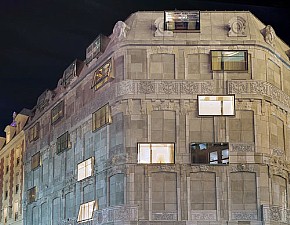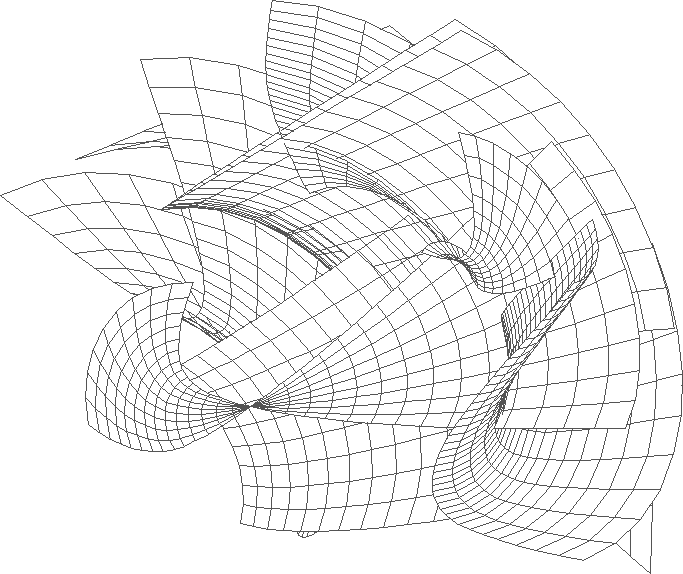2007.07.13 12:29
Sarcastic Architecture
I agree that 'sarcasm' does not fitly describe the work of VSB&I and Koolhaas/OMA. What I've found within the "ugly and ordinary" texts thus far are instances of the literary use of slight sarcasm usually at the end of a paragraph that culminates the point of a particular argument--like adding a bit of 'zing' at the end, a little akin to a punchline. Like I already said, the overall tone of the "ugly and ordinary" texts is not sarcastic.
As to the negativity of the text, yes it is there, but that is only to be expected in a polemic aimed at an orthodoxy.
Tagging Koolhaas/OMA as sarcastic is also hyperbolic, yet done with the intention to provoke further investigation, like Quilian's example of exaggerated program combinations above. While reading "ugly and ordinary" last night I too thought of 'cynicism'. I also thought I should next re-read Koolhaas's Junkspace.
One of things I'm getting out of all this is that solid criticism does (have to?) employ literary elements like cynicism, wit, satire and even some sarcasm. Sure, it comes off as negative, but it's really more metabolic, destructive and creative at the same time.
2007.08.04 14:41
Koolhaas & Eisenman Discuss "Urgency" at the CCA
About 180 more years of an architecture dominated by the combined assimilating and metabolic imaginations, and then roughly 500 years of an architecture dominated by a pure metabolic imagination. All the while the profane osmotic imagination remains in the background. So much for the physiology, morphologically a bi-polar structural cage will continue to branch and grow (till completion c. 3091).
--inside scoop from the ongoing embryonic development within.
2007.08.19 11:19
Why do you think you're creative?
The bird of paradise was definitely trying to be procreative, indeed prolific. Yet it's metabolism, a creative/destructive operation, that sustains almost all life.
Otherwise, the notion of being creative in the hope of making things better may be just as easily mean being creative due to discontent.
2007.08.20 15:37
Why do you think you're creative?
…most people don't even have a metabolic imagination. For that matter, even a fertile imagination is fairly uncommon.
2007.11.21 11:32
Complex Iconography and Contradictory Content in Architecture
Ah! Romulus and Remus, real brothers metabolic. It's said their father was a god and their mother a raped virgin. They say the father of Jesus was God and his mother an unraped virgin.
2007.12.03 08:05
Guess Who
..but what about the subcategories of profane and sacred space?
fertile space
conceptual space
assimilating space
metabolic space
diaphragmic space
networked space
osmotic space
electromagnetic space
all-frequency space
| |
2007.12.03 09:19
Guess Who
…both the profane and the sacred are human "being". Take away the qualifying hierarchy and you'll see the whole picture, which is much more.
After reading The Sacred and the Profane perhaps pick up Slovoj Zizek, The Puppet and the Dwarf: The Perverse Core of Christianity. It might help fill out the "whole picture."
I forgot a subcategory:
fertile space
conceptual space
pregnant space
assimilating space
metabolic space
diaphragmic space
networked space
osmotic space
electromagnetic space
all-frequency space
For a school I'd go:
inside -- assimilating space and all-frquency space
outside -- metabolic space
2008.03.13 17:21
Eisenman vs Zumthor theoretical approach
Eisenman: assimilating and metabolic imaginations
Zumthor: assimilating and pre-natal all-frequency imaginations
Eisenman, somewhat still-born
Zumthor, somewhat pregnant
2008.03.13 19:28
Eisenman vs Zumthor theoretical approach
Some architectures are extreme.
Some architectures are fertile.
Some architectures are pregnant.
Some architectures are assimilating.
Some architectures are metabolic.
Some architectures are osmotic.
Some architectures are electro-magnetic.
Some architectures are total frequency.
Figuring out what buildings/architects fit in which category(s) may well be the ultimate architectural parlor game. (Hint: Classical is high fertility and Gothic is early pregnancy.)
--1999.03.10
2008.03.22 14:53
Eisenman vs Zumthor theoretical approach
Eisenman: assimilating and metabolic imaginations
Zumthor: assimilating and pre-natal all-frequency imaginations
Eisenman, somewhat still-born
Zumthor, somewhat pregnant
assmilation: absorption
extreme assimilation: purge
metabolic: creative/destructive duality
pre-natal: synaptical
all-frequency: synapses
still-born: delivery and that's it
pregnant: delivery forthcoming
| |
2008.08.13 16:37
when thought matters
It was the Hypnerotomachia Poliphili and its profanation of love. "Religion of materiality" and capitalism as today's real religion.
The symbolic isn't dead, merely profaned. Just look at higher education as the symbolic profaned via its high price.
As to architecture profaned, I'm thinking of something along the lines of how html and the internet profaned publishing.
The assimilating imagination and the metabolic imagination are the more profane imaginations, whereas the osmotic imagination and the electro-magnetic imagination are the more sacred imaginations. They can all be utilized when it comes to design.
2008.08.14 08:13
when thought matters
The proposition of a metabolic imagination & an assimilating imagination relative to an osmotic imagination & an electromagnetic imagination stems from the design (morphology and physiology) of the human body. The diaphragm separates the abdominal cavity from the throatic cavity. The primary operations within the abdominal cavity are assimilation (digestive tract) and metabolism (liver), while the primary operations within the throatic cavity are osmosis (lungs) and electromagnetism (heart). The diaphragm aids in respiration, defecation and partuition (giving birth). Note how the role of the diaphragm correlates directly to Eliade's 'formula' of transcendence from profane to sacred.
The main proposition is that the human mind, the imagination, operates like the body it is bottom up from. In Peircian terms then, the design of the human body is the perpetual index, symbol and icon of human imagination.
Cultures (religion, drugs, etc.) are mostly superficial modifications of the human body and imagination.
2008.08.22 17:50
peter's canon
Both Einsenman's and Koolhaas's designs reflect the assimilating and metabolic imaginations. Yet Eisenman's designs remain mostly still-born, whereas Koolhaas's designs are reaching puberty.
2008.10.20
Architecture in Critical Condition, continued
After reading about Liszt, I read about Lister which was all about anticeptic operating procedure origins--interesting coincidence.
Another possibility for “Waiting Room” is to tackle the Working Title Museum.
Now, what is “Operation a Sucess; Patient Dead” going to be about? I have no idea right now. Is it a joke like the expression of the chapter title itself? Is it a paradox? How is architecture (today) a paradox? Does it have to do with really being metabolic? Being creative/destructive? That would certainly be a fine lead, and I’ll have to go over my metabolic material and maybe just formalize it all.
“Malpractice Case: Houses” is all about my zany domestic architecture designs and how they got to be that way.
“Eternal Wrest” will have to do with reenacting with a twist as a constant generator of originality.
| |
2008.10.25 11:20
front-line ideas + regional tradition = potential for a design culture of thinking/making?
See: Emmanuel Petit's "Incubation and Decay: Arato Isozaki's Architectural Poetics--Metabolism's Dialogical "Other"" in Monster.
2009.02.13 08:24
pragmatists turning political?
imaginative
scientific
fictive
Are there architectures that perform assimilatingly? metabolically? osmotically? electro-magnetically? ultra-frequently?
per..........form
re..........present
re..........enact
ars ludi
2009.03.16 11:28
Venturi's Lieb (No. 9) House to be moved (or demolished)
Most prevalent in our time: the assimilating imagination, the metabolic imagination.
2009.06.17 14:49
fouquet's barriere hotel
 the real: great design, very 21st century, consummate use of the assimilating and metabolic imagination.
the real: great design, very 21st century, consummate use of the assimilating and metabolic imagination.
the virtual: the renderings are now inconsequential.
2009.09.15 07:57
LET'S BUY A HOUSE IN DETROIT
Seeing Berlin as a metabolic city, I then wondered about Detroit and whether it's also metabolic. Via chronosomatic theory, I then came to see Detroit as more assimilating in both extremes.
| |
2009.10.25 10:11
Really, what boundaries have you pushed?
Might we then conclude that pushing boundaries is uncommon, and muddling-through, (drunken) rage, and even pretense are common?
Does pushing boundaries a least require a metabolic (destructive/creative, challenging/advancing) imagination?
2010.09.21 15:49
institutional critique [sort of]
I too, just last week, read of Gandy and his perspective of the Bank of England:
"Girardin's unfinished temple even today forces the observer to do a double-take. No matter how much we are prepared for it, the realization that the building is unfinished, and not a ruin, is difficult to internalize. Indeed, the attraction of such architectural indeterminacy led to a fascinating type of didactic representation in the nineteenth century that curiously links John Soane and Joseph Gandy to Violette-le-Duc and Choisy. At the beginning of this chain lies Gandy's watercolor of Soane's Bank of England exhibited at the Royal Academy in 1830. It shows the entire block Soane began working on in 1788 in a cutaway aerial perspective taken from the southeast. A storm has just passed over the building, appearing to leave in its wake a path of destruction brought to light in the ensuing calm. Bu on closer inspection, what at first seems to be a ruin is verisimilarly a projection of the site under construction."
Neil Levine, "The Architecture of the Unfinished and the Example of Louis Kahn" in Fragments: Architecture and the Unfinished (2006), p. 327.
It's interesting to note the metabolic (destructive/creative) nature of Gandy's "view." Perhaps "institutional critique" is inherently metabolic.
[There are seeds of "The Architecture of the Unfinished and the Example of Louis Kahn" within Levine's earlier (1989) "Robert Venturi and "The Return of Historicism"".]
2011.09.09 08:31
Future Trends in Architecture
2003.09.08: Very 23rd century: less assimilation is more metabolic.
2012.05.24 11:45
the ethics of parametricism/emergent architectural thought and reification

Sorry for posting the same image again, but I want to add one more thing about it: there is not a single curved line within the entire image; the whole image is composed of straight lines. I realize the notion of mimicry here--straight lines 'mimicing' curves--is narrow, but I'll stay with the notion of imagining the image as something other than what it really is. My intention is not to discount at all what you first said about mimicry, and it looks like I too am guilty of not being true to the metaphor.
On adjusting the imagination, I'd say there are seven main imaginations to adjust into: extreme imagination, fertile imagination, assimilating imagination, metabolic imagination, osmotic imagination, electro-magnetic imagination, all-frequency imagination. tammuz, I'm not putting you off, but I really don't have that much time today--maybe have this 'adjusting the imagination' discussion in another thread?
|